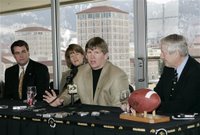It has been snowing in Idaho and I have been yearning for wide open spaces.
It also snowed the early June day I arrived at
Safari Club's American Wilderness Leadership School (AWLS) a few summers ago. I stared, dismayed, as it fell in silent paths outside the meeting room window. My roommates, from Florida appropriately, raced outside, cameras in hand. I was more than eager to see the snow melt, having emerged from a long winter in Idaho and anticipating the carefree days of summer.
Yet the snow could not hide the loveliness of the valley where we were tucked away—the Gros Ventre Wilderness area southeast of Jackson Hole, Wyoming.
Each morning the bell rang for breakfast between 7 and 7:30. I fought my late-rising tendencies while a cabin full of teachers, accustomed to early mornings, bounced out of bed. Every meal at AWLS is preceded by a "thought" (Is praying before meals forbidden in the outdoors?), so we gave thanks for our food silently.
I spent one of my first mornings attempting the delicate art of fly-tying, looking like an elf in Santa's workshop, bent over my vice, hook extended, bobbin in hand, carefully threading the yarn, the chenille, the feather—one by one over a small hook. I couldn't imagine what all the fuss was over this tedious process, but what appeared at the end of the experiment was worth the tying and retying, winding and rewinding: my own pseudo-insect, suitable for fly-fishing. Fancying myself a pro, I daydreamed about making fly-tying a hobby but promptly forgot the entire process when I left the room.
Our second day, on a tour of the School’s grounds, we were warned about getting between a moose and her calf that frequented the salt lick, strategically placed a safe, but unobstructed distance from the cafeteria windows. We were warned about the bears, too—Grizzly and Black. And, oh joy! the Grizzlies had grown in population at an astonishing rate. The year before our visit about 24 sows gave birth--an average of 3 cubs apiece. While I know this marks a triumphant return for the Grizzly, I had mixed feelings about it.
From the history of the most insignificant hilltop to the name of an obscure wildflower, our instructors turned every inch of that rugged land into a lesson. But I learned more than the statistical data and anecdotes could teach me. I discovered the importance of the wilderness: It captures our imagination, when the photos and the movies are just cheap imitations. It reminds us that we are small and that there is more to life than email and the nightly news. The mountains bear down upon so that we don't forget we are, after all, a breath; that there is so much out of our control; that there is something stronger and Greater than we are. Creation silences the noise of our everyday lives and sings the song of eternity in our hearts.
One night around the campfire, someone commented on the wonder of the lifestyle out here in the "West." I had to smile. Most people "out West" don’t live the way we got to live at AWLS—surrounded by like-minded, amiable friends, unburdened by the demands of work and family, and eating three square meals a day prepared by someone else.
And it is foolish to think we all should stay in this happy place, all of the time. It’s even more foolish to lock up the land so we cannot reasonably enjoy it. But to able to return to it—that is the true gift, the real message of the outdoors.






